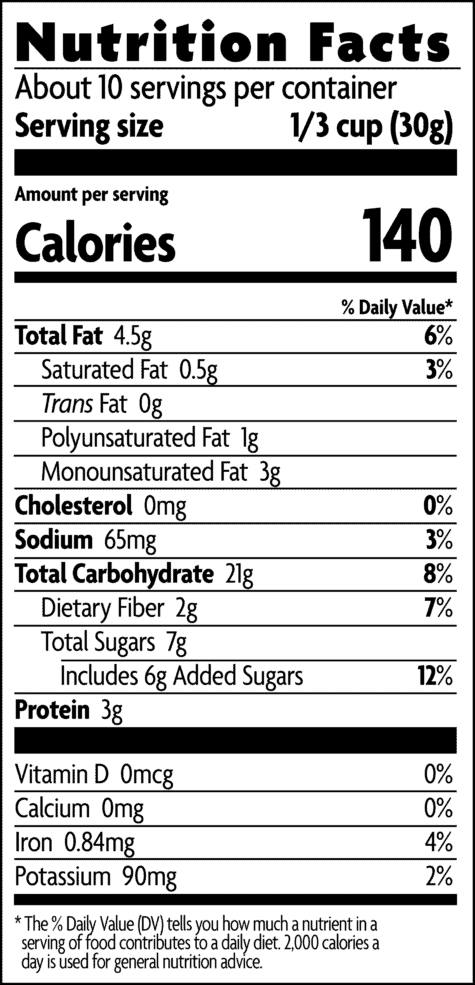Avoid These 3 “Health Foods” That Are Actually Unhealthy
Our society has gotten good at labeling foods as “healthy” or “unhealthy.” This is in part due to the FDA, health organizations, businesses, healthcare professionals, nutritionists, etc.
Are they categorizing them correctly though?
In part, it depends on who is doing the labeling.
A food company might market a product as “healthy,” but when you look at the nutrition label, it’s anything but.
Healthcare professionals should know the difference between healthy and unhealthy foods. However, I’ve shockingly met some who don’t. My husband’s ex-wife is one of them (don’t worry, she’s not going to read this).
Government agencies may have their own agendas when it comes to promoting healthy versus unhealthy foods. So, keep that in mind.
Nutritionists are often very reliable sources, so that’s comforting at least. However, sometimes their own personal biases come into play, which is normal human behavior.
As you can see, it’s hard to know who to be able to rely upon. That’s completely normal though, because the terms “healthy” and “unhealthy” are somewhat subjective.
It’s best to get informed, and then make the ultimate decision yourself. After all, it’s your body that the food or beverage is going into.
If you are informed, then you will be equipped to make the right decision for yourself. I’m betting you’ll sure to avoid these “health foods” that are actually unhealthy.
I do want to be clear though, I’m not opposed to indulging. I’m actually a fan of it! I’m just not a fan of you being misled by food companies, agencies, etc. though.
Granola is a Health Food That is Unhealthy
Granola sounds so healthy, doesn’t it? Especially if it’s organic, small batch, and made in the cute, mountainous state of Vermont. If you look at what’s on the ingredients list and nutrition label, you might classify this more as a dessert though.
For this, I looked at a few different brands of organic granola and pulled a granola recipe off the internet, to find some common ingredients. The granola recipe had three sweeteners in it and the organic brands had at least two (yikes!).
The Typical Ingredients in (Organic) Granola
oats
sunflower seeds
nuts (oftentimes walnuts, pecans, almonds, cashews)
dried fruit and/or chocolate chips
brown sugar or evaporated cane sugar
maple syrup
honey
vegetable, sunflower seed or coconut oil
vanilla
salt
cinnamon
As you can see, some of these are healthy, but about half are not. Unfortunately, it’s also the volume of the sweeteners and oil that make it less healthy. In order for granola to clump together and form a nice crunch, you need to have a fair amount of both.
The Nutrition Label
Here I looked at several nutrition labels for organic granola and they were all fairly similar. Here’s a look at the nutrition label from a Nature’s Path Organic Honey Almond Granola, which is a popular brand.
I actually found others that had a higher sugar, fat, or calorie count, however this one was more average. I don’t want you to never eat granola again, as it is delicious. Also, it’s certainly more nutritious than a donut!

Because this has so much oil and sugar, it is a calorie-dense food, with a whopping 140 calories for only 1/3 of a cup! So, if you are trying to watch your sugar and calorie intake, just be aware that granola might be working against you.
And granola bars, for that matter.
- Read (or skim) this too: 9 Sneaky Sources of Calories Preventing Weight Loss
- GET WEEKLY TIPS: Eating Habit and Weight Loss Tips
My Ended Love Affair With Granola Bars
Let me tell you a story about granola bars and I.
Once upon a time, I was obsessed with granola bars. I ate them every day as a “healthy snack.”
I even started making them.
If I could’ve eaten granola bars for every meal, I would have. That didn’t happen though, but only because I knew I should spread the love and eat other foods too.
But if I could stay exclusive with granola bars, I totally would have.
Until I realized that they were essentially candy bars, packaged and marketed as a “health food.” Such betrayal!
I immediately ditched them. No chance for reform, apologies, or the like. I ended that love affair faster than you’d turn down your creepy coworker’s date proposition to go bowling and grab dinner at McDonald’s afterward.
Granola bars usually have similar ingredients as granola, but oftentimes have more sugar, giving a chocolate bar a run for its money!
- Read (or skim) this too: Sugar Addiction: How to Stop the Cycle
- GET WEEKLY TIPS: Eating Habit and Weight Loss Tips
Vegetarian and Vegan Meat and Dairy Alternatives
I want to preface this with, I was once a vegetarian and think there are many wonderful things about being vegetarian. However, companies that make vegetarian meat alternatives really need to start caring more about their ingredients.
Some people are vegetarian because they are animal lovers and would rather not eat their furry or feathered friends. Others believe that meat is unhealthy, therefore they decide not to eat it.
Regardless, food items such as veggie burgers, veggie sausage, dairy-free cheese, and vanilla soy milk aren’t as healthy as are marketed as. They are great examples of “health foods” that are unhealthy.
Did you know that veggie burgers oftentimes have barely any vegetables in them and are made up of some pretty yucky stuff?
Here’s what Boca Burger lists on their ingredients for their Original Vegan Veggie Burger:
WATER, SOY PROTEIN CONCENTRATE, WHEAT GLUTEN, CONTAINS LESS THAN 2% OF MODIFIED CELLULOSE, SALT, DRIED ONIONS, YEAST EXTRACT, SESAME OIL, HYDROLYZED WHEAT PROTEIN, NATURAL FLAVOR (NON-MEAT), DISODIUM GUANYLATE, DISODIUM INOSINATE, ARTIFICIAL FLAVOR.
I don’t see any vegetables in there besides dried onions, and I’m not exactly sure how much nutrition those little bits of dried onions provide.
What would constitute a healthy veggie burger, would be an ingredient list that includes beans, vegetables, lentils, nuts, and seasoning.
If you’re vegan or vegetarian, you’re definitely better off mashing up those ingredients to make your own veggie burgers. Just cook the patties on a large griddle and freeze the leftover ones.
If you’re curious about what’s in dairy-free cheese, check this out.
Here’s an ingredient list from Daiya’s Mozzerella cheese:
FILTERED WATER, TAPIOCA STARCH, EXPELLER-PRESSED: CANOLA AND/OR SUNFLOWER OIL, COCONUT OIL, VEGAN NATURAL FLAVORS, PEA PROTEIN, SALT, INACTIVE YEAST, XANTHAM GUM, LACTIC ACID (VEGAN), TITANIUM DIOXIDE COLOR, YEAST EXTRACT.
I can’t tell you what “vegan natural flavors” are, but at least the pea protein is healthy.
Organic Snacks
Organic is great, it’s the snack part that isn’t. An organic snack is just a packaged, processed snack food that uses organic ingredients. Organic simply means little to no pesticides were used.
Notice how I said, “little to no pesticides.”
That’s because in order for a company to label a food as “organic,” it must contain at least 95% organic ingredients, except for the water and salt.
If you’re familiar with Annie’s Organic Foods, here are the ingredients that are in Annie’s Organic Fruit Snacks:
ORGANIC TAPIOCA SYRUP, ORGANIC CANE SUGAR, ORGANIC TAPIOCA SYRUP SOLIDS, ORGANIC PEAR JUICE CONCENTRATE, WATER, PECTIN, CITRIC ACID, SODIUM CITRATE, ASCORBIC ACID (VITAMIN C), ORGANIC COLOR (ORGANIC BLACK CARROT, ORGANIC BLACK CARROT EXTRACTS), ORGANIC SUNFLOWER OIL, NATURAL FLAVOR, ORGANIC CARUBA WAX.
Basically, these organic snacks consist of organic syrup and sugar. Sounds real healthy, huh? Yet another example of a “health food” that is oftentimes unhealthy.
- Read (or skim) this too: Should You Break Your Habit of Snacking at Night?
- GET WEEKLY TIPS: Eating Habit and Weight Loss Tips
Now to be fair, I listed the ingredients for fruit snacks, which tend to be unhealthy in general.
However, Annie’s makes a lot of other organic snacks such as organic bunny grahams (which are little cookies). They also make organic cheddar bunnies, consisting of oil, organic flour (processed grains), salt and chemicals.
This is one of the more well-known (and loved) organic food and snack companies, but of course there are others that have worse and better ingredients.
What To Do if You’re in the Habit of Eating “Health Foods” That Are Unhealthy
You can continue if you’d like. Remember how I mentioned in the beginning that I’m just informing you, so you can make your own decision? Some of these foods aren’t necessarily harmful, so it really depends on your preferences and health goals.
Or, you may think twice about picking these up at the grocery store. If you were restricting yourself from eating that warm, homemade peanut butter cookie, but were planning on eating a granola bar, you may want to think about that again.
If you do tend to crave some of these foods and want to stop acting upon the cravings, this blog post will help…
- Read (or skim) this too: How to Conquer Your Eating and Drinking Urges
Final Notes
There are many other foods that companies market to sound healthy when they’re really not. There are too many to discuss here in this blog post, so I limited it to these 3 sneaky ones.
After all, I don’t want to ruin your day by telling you about ALL the unhealthy trickery out there.
This is why it’s important to take note, but make your own decisions about what you want to eat or drink. It really comes down to your health and body goals, and what feels right to you.
Try to make a habit of checking food labels to make sure these so-called “health foods” aren’t hiding behind the headline on the front of the box. They might be anything but healthy, especially if it’s a processed food.

KATE JOHNSTON
Eating Habits & Weight Loss Coach
Helping career women break free from emotional eating, overeating and mindless eating.
Start feeling more healthy, confident and free by clicking the button below.
